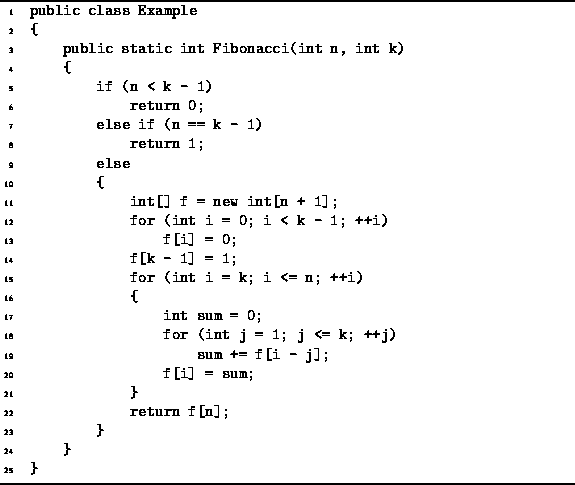|
Data Structures and Algorithms
with Object-Oriented Design Patterns in C# |
Consider the problem of computing the
generalized Fibonacci numbers .
The generalized Fibonacci numbers of order ![]() are given by
are given by
Notice that the ``normal'' Fibonacci numbers considered in Section ![]() are the same as the generalized Fibonacci numbers of order 2.
are the same as the generalized Fibonacci numbers of order 2.
If we write a recursive method
that implements directly Equation ![]() ,
we get an algorithm with exponential running time.
For example, in Section
,
we get an algorithm with exponential running time.
For example, in Section ![]() it is shown that
the time to compute the second-order Fibonacci numbers
is
it is shown that
the time to compute the second-order Fibonacci numbers
is ![]() .
.
The problem with the direct recursive implementation is that
it does far more work than is needed because
it solves the same subproblem many times.
For example,
to compute ![]() it is necessary to compute
both
it is necessary to compute
both ![]() and
and ![]() .
However, in computing
.
However, in computing ![]() it is also necessary to compute
it is also necessary to compute ![]() , and so on.
, and so on.
An alternative to the top-down recursive implementation is to do the calculation from the bottom up. In order to do this we compute the series of sequences

Notice that we can compute ![]() from the information contained
in
from the information contained
in ![]() simply by using Equation
simply by using Equation ![]() .
.
Program ![]() defines the method Fibonacci
which takes two integer arguments n and k
and computes the
defines the method Fibonacci
which takes two integer arguments n and k
and computes the ![]() Fibonacci number of order k
using the approach described above.
This algorithm uses an array to represent
the series of sequences
Fibonacci number of order k
using the approach described above.
This algorithm uses an array to represent
the series of sequences ![]() .
As each subsequent Fibonacci number is computed
it is added to the end of the array.
.
As each subsequent Fibonacci number is computed
it is added to the end of the array.

Program: Dynamic programming example--computing generalized Fibonacci numbers.
The worst-case running time of the Fibonacci method
given in Program ![]() is a function of both n and k:
is a function of both n and k:
![]()